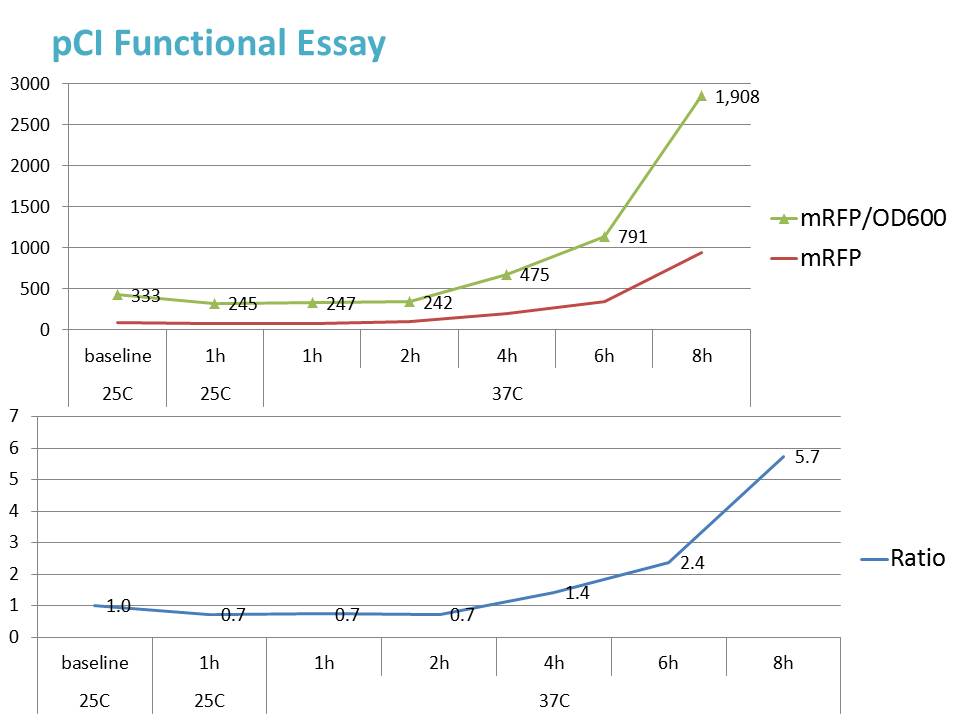Team:NTU-Taida/Human Practice/Information-Platform
From 2012.igem.org
(Created page with "Facebook PAGES and Blog In order to let more people know about synthetic biology and the competition of iGEM, We not only held several campaigns between other Taiwanese iGEM tea...") |
|||
| Line 1: | Line 1: | ||
| - | + | __FORCETOC__{{:Team:NTU-Taida/Templates/Header}}{{:Team:NTU-Taida/Templates/Navbar}}{{:Team:NTU-Taida/Templates/Sidebar|Title=Information Platform}}{{:Team:NTU-Taida/Templates/ContentStart}} | |
| - | + | {{:Team:NTU-Taida/Templates/BSHero|Title=Human Practice: Information Platform|Content=}} | |
| - | |||
| - | + | ==Modified P<sub>CI</sub>== | |
| + | <p style="text-indent: 2em;">The circuit incorporates a temperature sensitive cI promoter(CIts) to sense the temperature upshift. In our test we use a thermal adjustable plate reader to detect the mRFP flurorescence. In the beginning, we keep the temperature under 30 Celsius degrees for over 1 hour, and then detect the emission of mRFP. As the dimerized CIts repressor in lower temperature would specifically bind and repress P<sub>CI</sub>, and further hinder the expression of mRFP. We can expect the emission to be low under 610 nm wavelength. We then abruptly increase our temperature to 37 celsius degrees, as we expect the CIts dimer would decompose and lose the function of repressing mRFP expression. </p> | ||
| - | + | [[File:NTU-Taida-Result-Thermal-pCI.png|600px|center]] | |
| - | |||
| - | + | <p style="text-indent: 2em;">The result showed a low level of mRFP expression under wavelength of 580 nm (excitation) and 610 nm (emission). After the sudden temperature upshift, the expression of mRFP steadily rises, and results in 5.7 folds increase in the 8th hour after the temperature upshift. </p> | |
| + | <p style="text-indent: 2em;">This proved the fact that repressor CIts and P<sub>CI</sub> can largely lead to increase in protein expression, and can be used in our circuit design as it may turn on the circuit inside human body and spontaneously close down after the bacteria is expelled out. </p> | ||
| + | |||
| + | |||
| + | <!-- EOF --> | ||
| + | {{:Team:NTU-Taida/Templates/ContentEnd}}{{:Team:NTU-Taida/Templates/Footer|ActiveNavbar=Result, #nav-Result-Modified}} | ||
Revision as of 13:43, 26 October 2012
Human Practice: Information Platform
Contents |
Modified PCI
The circuit incorporates a temperature sensitive cI promoter(CIts) to sense the temperature upshift. In our test we use a thermal adjustable plate reader to detect the mRFP flurorescence. In the beginning, we keep the temperature under 30 Celsius degrees for over 1 hour, and then detect the emission of mRFP. As the dimerized CIts repressor in lower temperature would specifically bind and repress PCI, and further hinder the expression of mRFP. We can expect the emission to be low under 610 nm wavelength. We then abruptly increase our temperature to 37 celsius degrees, as we expect the CIts dimer would decompose and lose the function of repressing mRFP expression.
The result showed a low level of mRFP expression under wavelength of 580 nm (excitation) and 610 nm (emission). After the sudden temperature upshift, the expression of mRFP steadily rises, and results in 5.7 folds increase in the 8th hour after the temperature upshift.
This proved the fact that repressor CIts and PCI can largely lead to increase in protein expression, and can be used in our circuit design as it may turn on the circuit inside human body and spontaneously close down after the bacteria is expelled out.
 "
"


